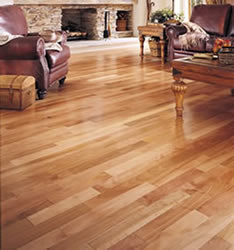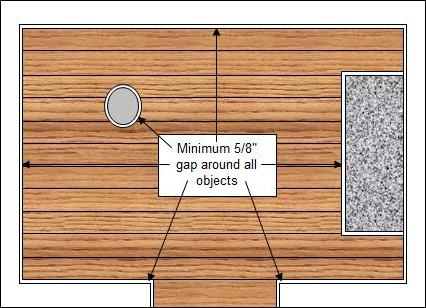There is nothing more beautiful, elegant and impressive than a hardwood floor, (Figure 1). Yet, if not installed properly a hardwood floor will buckle, cup and warp. Ninety percent of all the problems encountered with hardwood flooring can be traced back to improper installation, which includes inadequate preparation of the sub-floor below the hardwood flooring.

Figure 1 - Hardwood floor
Hardwood flooring and laminate flooring are not installed using the same guidelines of expansion and contraction. Many of the sales associates in big box retail centers do not have the training or experience to assist the home handyman in the proper installation of hardwood flooring, they make the assumption that gaps between walls and the flooring material are the same no matter what flooring material is being used.
When installing hardwood flooring it is important that a gap is left between the new hardwood floor boards and walls around the entire perimeter of the room. In fact there must be a gap left between any vertical object and the horizontally placed boards. This includes fireplace hearths, door thresholds and columns.
The gap between the hardwood flooring and any obstruction should be a minimum of 5/8 inch and 3/4 inch is actually better, as shown in Figure 2. The larger the room, the larger the gap must be. This is because the hardwood flooring expansion occurs on each board. The total expansion possible is a direct resultant of how many boards there are times the expansion of each board. The bigger the room, the more boards necessary to cover the floor and the more boards necessary to cover the floor the greater the overall expansion.
As an example, if your room is 10 feet wide and you are using 3 inch hardwood boards and each board was to expand 1/64 of an inch, the total expansion would be: 40 boards × 1/64 inch = 5/8 inch. If the room was 12 feet wide you would have a total expansion of: 48 boards × 1/64 inch = 3/4 inch
Note: In practice all of the hardwood boards would not expand equally as the expansion is relative to how much moisture would enter the board and that is relative to the grain in any specific board.

Figure 2 - Hardwood Flooring - Expansion Gap
Hardwood flooring expands and contracts based on its moisture content. The moisture content of the hardwood flooring is relative to he humidity levels in the area where it has been installed. As moisture increases in the hardwood flooring the boards will expand and as the moisture levels lessen, the boards will contract.
One of the most important installation steps is to ensure that the hardwood flooring that you are planning on installing is left in the room where it is to be installed for a minimum of 72 hours, with any plastic wrap on the boxes of hardwood flooring removed. This is probably one of the biggest errors made by installers and home handymen. Everybody is anxious to complete the project. You purchase the hardwood flooring, bring it home and immediately commence installation. Or, as an alternative, you come home and stack the boxes in the garage! Most lumber retailers store their products in warehouses that are not climate controlled and even if they are, they will not have the same humidity levels as your home.
Additional information on: Acclimatizing hardwood flooring
Hardwood flooring manufactures will provide specific instructions for acclimatizing their hardwood boards prior to installation. Always follow the manufacturers instructions!
If the hardwood flooring is not acclimatized to the room that it is going to be installed in, once installed it will acclimatize and that means that it will either expand or contract depending on the humidity level in the room. Problems will occur in a few short weeks after installation. Either gaps will develop between boards as the hardwood flooring boards contract in width or the boards will buckle as they try to expand with no where to go!
Providing a gap between objects and your hardwood flooring and acclimatizing the hardwood flooring boards applies to both nail down and glue down installations.
Gluing the hardwood flooring to either a wood or concrete sub-floor provides one of the most stable methods of installation. However, it should be noted that it takes a lot more effort and expertise to glue down the hardwood flooring than to nail it down. The proper hardwood flooring adhesive will have an elastic quality which will allow the hardwood flooring to expand and contract without buckling.

Figure 3 - Moisture meter
Always spread the glue on the sub-floor. Never apply the glue to the individual hardwood boards.
To install hardwood flooring over a concrete sub-floor you must first ensure that concrete sub-floor does not contain a high moisture content using a moisture meter (Figure 3). Anything over a 4% moisture content in the sub-floor will create problems after installation. You have to alternatives, if you have a higher than acceptable moisture content in the concrete sub-floor. You can delay installation until the floor dries out. Or, you can use a moisture barrier primer over the concrete.
Note; If you are planning to install a hardwood floor over a newly poured concrete sub-floor you must wait a minimum of 60 days to allow the concrete to properly cure before installing the hardwood flooring.
Concrete sub-floors must be smooth, level and not cracking, chipping or have other problem areas in the surface. If the floor has damage or is not level, it can be repaired using a concrete self leveling compound. It is also important that any grease, oils or other grime be completely removed. Use a good quality concrete cleaner that is not solvent based, as the solvents remaining on and in the concrete will not allow the hardwood flooring adhesives to bond properly.
Additional information on: Installing hardwood flooring on concrete sub-floors
Installing hardwood flooring over a wood slat sub-floor can present problems, especially if the sub-floor is not truly flat, has gaps between the slats or has flex. In this instance it is best practice to install a plywood sub-floor on top of the wood slats.
Additional information on: Installing hardwood flooring on a wood sub-floor
Note: If the floor squeaks it is important that the squeaks are repaired prior to the installation of the hardwood flooring. Installing hardwood flooring, in most cases, will not eliminate squeaks in a floor.
Additional information on: Repairing squeaks in floors
